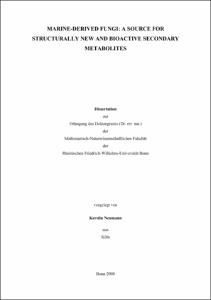Neumann, Kerstin: Marine-derived fungi : a source for structurally new and bioactive secondary metabolites. - Bonn, 2009. - Dissertation, Rheinische Friedrich-Wilhelms-Universität Bonn.
Online-Ausgabe in bonndoc: https://nbn-resolving.org/urn:nbn:de:hbz:5N-17696
Online-Ausgabe in bonndoc: https://nbn-resolving.org/urn:nbn:de:hbz:5N-17696
@phdthesis{handle:20.500.11811/4080,
urn: https://nbn-resolving.org/urn:nbn:de:hbz:5N-17696,
author = {{Kerstin Neumann}},
title = {Marine-derived fungi : a source for structurally new and bioactive secondary metabolites},
school = {Rheinische Friedrich-Wilhelms-Universität Bonn},
year = 2009,
month = may,
note = {The marine habitat has been proven to be a rich source for both macro- and microorganisms that produce novel and often highly bioactive natural products. Hence, the investigation of the secondary metabolite spectrum of marine fungi represents a valuable approach in the search for new and bioactive natural products. The present study thus focused on the investigation of marine-derived fungi with the aim to isolate bioactive secondary metabolites via a bioassay-guided isolation strategy. Special emphasis was placed on new structural types and their ability to act as antitumor or, in second priority, antibiotic agents.
From the cytotoxicity screening program undertaken within the Institute for Pharmaceutical Biology, five fungal strains with cytotoxic activity towards cancer cells and interesting chemical features, i. e. 1H-NMR and LC-MS data, were chosen for detailed investigation. From these fungal cultures altogether 19 compounds and two peptidic mixtures have been isolated and their structures characterized.
The sorbicillin derivatives trichodermanones A-D (1-4) were obtained from the sponge-derived fungus Trichoderma saturnisporium. The trichodermanones are remarkable because of their unprecedented carbon skeletons, most likely originating from two different polyketide units that have been connected via a Diels-Alder reaction during biosynthesis. One of these units can be described as sorbicillin-like, characterized by a cyclohexanone ring with an attached six-membered side chain (sorbyl moiety). The second structural part which is a pyrane ring in 1-3 and a lactone ring in 4 is possibly triketide-derived (ring C). The structures of the compounds, including the absolute stereochemistry, were determined by interpretation of their spectroscopic data (1D and 2D NMR, CD, MS, UV and IR) and molecular modelling calculations.
Bioassay-guided isolation of the cytotoxic crude extract of Beauveria bassiana led to the isolation of the new cytotoxic tetramic acid derivative beauversetin. A compound of the same structural type, the tetramic acid sch210972 was found to be produced by the sea weed-derived fungus Microdiplodia sp. and showed strong human leucocyte elastase (HLE) inhibitory activity with an IC50 value of 1.04 µg mL-1. HLE plays a role in several inflammatory diseases such as pulmonary emphysema or chronic bronchitis and thus represents an important target for drug research. Our results show that tetramic acids represent a new lead structure for the development of potent HLE inhibitors.
The compounds isolated during this study impressively demonstrate the structural diversity of fungal secondary metabolites. The trichodermanones are a formidable example for unique structures from marine-derived fungi. Furthermore, the discovery of tetramic acids as inhibitors of HLE showed that the marine habitat is a rich source for structurally novel compounds which can serve as lead structures for the development of novel and innovative drugs.},
url = {https://hdl.handle.net/20.500.11811/4080}
}
urn: https://nbn-resolving.org/urn:nbn:de:hbz:5N-17696,
author = {{Kerstin Neumann}},
title = {Marine-derived fungi : a source for structurally new and bioactive secondary metabolites},
school = {Rheinische Friedrich-Wilhelms-Universität Bonn},
year = 2009,
month = may,
note = {The marine habitat has been proven to be a rich source for both macro- and microorganisms that produce novel and often highly bioactive natural products. Hence, the investigation of the secondary metabolite spectrum of marine fungi represents a valuable approach in the search for new and bioactive natural products. The present study thus focused on the investigation of marine-derived fungi with the aim to isolate bioactive secondary metabolites via a bioassay-guided isolation strategy. Special emphasis was placed on new structural types and their ability to act as antitumor or, in second priority, antibiotic agents.
From the cytotoxicity screening program undertaken within the Institute for Pharmaceutical Biology, five fungal strains with cytotoxic activity towards cancer cells and interesting chemical features, i. e. 1H-NMR and LC-MS data, were chosen for detailed investigation. From these fungal cultures altogether 19 compounds and two peptidic mixtures have been isolated and their structures characterized.
The sorbicillin derivatives trichodermanones A-D (1-4) were obtained from the sponge-derived fungus Trichoderma saturnisporium. The trichodermanones are remarkable because of their unprecedented carbon skeletons, most likely originating from two different polyketide units that have been connected via a Diels-Alder reaction during biosynthesis. One of these units can be described as sorbicillin-like, characterized by a cyclohexanone ring with an attached six-membered side chain (sorbyl moiety). The second structural part which is a pyrane ring in 1-3 and a lactone ring in 4 is possibly triketide-derived (ring C). The structures of the compounds, including the absolute stereochemistry, were determined by interpretation of their spectroscopic data (1D and 2D NMR, CD, MS, UV and IR) and molecular modelling calculations.
Bioassay-guided isolation of the cytotoxic crude extract of Beauveria bassiana led to the isolation of the new cytotoxic tetramic acid derivative beauversetin. A compound of the same structural type, the tetramic acid sch210972 was found to be produced by the sea weed-derived fungus Microdiplodia sp. and showed strong human leucocyte elastase (HLE) inhibitory activity with an IC50 value of 1.04 µg mL-1. HLE plays a role in several inflammatory diseases such as pulmonary emphysema or chronic bronchitis and thus represents an important target for drug research. Our results show that tetramic acids represent a new lead structure for the development of potent HLE inhibitors.
The compounds isolated during this study impressively demonstrate the structural diversity of fungal secondary metabolites. The trichodermanones are a formidable example for unique structures from marine-derived fungi. Furthermore, the discovery of tetramic acids as inhibitors of HLE showed that the marine habitat is a rich source for structurally novel compounds which can serve as lead structures for the development of novel and innovative drugs.},
url = {https://hdl.handle.net/20.500.11811/4080}
}






